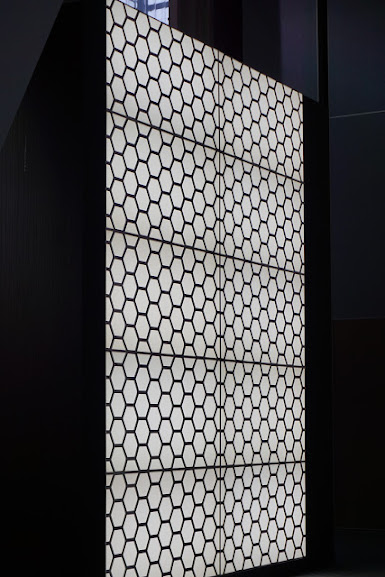I learned a lot about textiles while at
Decorex during London Design Week
and visiting many fabric houses
Introducing A New Column,
TEXTILE DIARIES
Dear Readers,
I am excited to introduce TEXTILE DIARIES where I hope to entertain and inform on this fascinating subject. I have yet to meet a design aficionado who does not love fabric. As a matter of fact, most fellow design lovers are obsessed with textiles from prints to cut velvets. In my early days after graduating from Parsons School of Design I was a "runner" for a few design firms at the same time, meaning I literally ran through the NYC's D&D building daily to shop and pick up fabric and wallpaper choices for their clients. Keeping a bag per firm under each arm to help me stay organized, I spent hours wiled away in the back of showrooms flipping through the expansive wings (as they call it) of fabric, sometimes on boards other times drapery length with the following color way skews cascading down the drape.
My love for fabric was cemented many moons ago. I could still spend hours looking, archiving and feeling fabric. When I've traveled to Italy and other countries outside the States, I almost always bee-line it straight to the fabric shops. For decades, I've been a collector of vintage lace and fabrics. So, long story short, I love fabric. No surprise there since five years ago I embarked (alongside my good friend and artist Susan Young) to start creating and manufacturing our own line of fabric and wall coverings. It started out small but quickly became a burgeoning business. We are a woman-owned American-made firm, and together Susan and I imagine, design and manufacture all our own products. Today, our designs are represented in showrooms and shops around the country, and we were giddy to have been awarded 2019 IFDA Rising Stars of Product Design.
So, here in this bi-weekly column we will write about textiles - their history, how they're made, the artists behind the fabric and more interesting tidbits. Please let me know if there is a subject matter you'd like me to cover- rootcellardesigns@gmail.com
Happy Nesting
XO Tamara
Our Love For Chintz Returns Again and Again...
The Why, How & When-
And, Are We Interested In Modern Day Chintz?
an ancient chintz at the Cooper Hewitt museum in New York City a beautiful rendering of what decorator Elsie de Wolfe would create at the Colony Club in 1907 including lots of Chintz for the ladies who lunched
The History of Chintz and its popularity
The roots of Chintz go deep, back over 500 hundred years. Originally made in India the word Chintz comes from the Hindi name "chint"meaning spotted. The Dutch introduced Chintz to Europe in the 17th century. Soon the manors in France and fine homes in England were using this richly color-saturated textile everywhere in the home. The house of Versailles used it even when it was temporarily banned in Europe. During the Industrial Revolution, factories throughout Europe started producing the fabric rather than importing it.
Who were the influencers of Chintz and made it popular here in the States? Cut to 1907 it was celebrated during the opening of one of the most prestigious ladies-only private clubs in America, The Colony Club where interior decorator Elsie de Wolfe used chintz freely. Nancy Lancaster and her new decorating firm Colefax & Fowler helped to make Chintz wildly popular in the decorating world in the 1940s. Then in the 60's Jackie Kennedy showcased an "orange blossom chintz" in the White House. Again, in the 1980's Nancy Reagan decorated the White House with Chintz. Soon Interior decorator Mario Buatta become known as the "Prince of Chintz" in New York circles where he fine-tuned his fascination with this old-world look. When IKEA came on the scene in the 1990s they introduced a minimalistic aesthetic and basically called for the end of Chintz. However, it's been on the scene again most recently in the last few years with the whole "Maximalism" design aesthetic...you see, if you wait long enough history will repeat itself.

One of the Chintz frontiers...
Many modern day designers continue to be inspired by 20th century interior decorator Nancy Lancaster who was American but became known as one of the great British interior decorators of her time. In 1948, she bought England's well known decorating firm and fabric and wall covering manufacturer from her friend Sibyl Colefax, known today as Colefax & Fowler. The influential firm re-created the English Country Home style often showing beautiful layering of tapestries and textiles and art. The movement helped to popularize chintz and make that wonderfully lived-in yet rich aesthetic popular - a look we've all collectively come to know and love today inspired by the English Country Home. Nancy Lancaster's personal bedroom
Chintz showcased by Nancy Lancaster
In the 1980s, New York Interior designer, Mario Buatta became known as the "Prince of Chintz" throughout his illustrious career. He was one of the first decorators who appeared in many magazine pages and often wrapped in his favorite Chintz fabric. He made Chintz chic. He was most likely inspired by Nancy Lancaster and designers and designs from the past with his design style which appealed to the growing affluent culture and lifestyle of the 1980s.
What to love about Chintz?
It's durability is something many relish. Today, due to modern technologies and performance fabrics, we have a plethora of durable fabrics to choose from that perform well, but back then it was equally important to have fabric that wore well over time. Investing in drapery and upholstery is an expensive endeavor. Additionally, it has a luxurious feel and drape and the way it prints the colors seem almost infused with richer hues. It certainly adds a bit more of a formal feel compared to a simple printed linen or cotton.
While we've moved on from Chintz as our mainstay fabric in homes in the States, many who love textiles pine away for it. Here in our root cellar designs' studio we talk about Chintz often. We realize the world has changed, the modern day fabric is a super version of the past in terms of durability and versatility but we love the old look, feel and the hand of precious fabric that was made in the European ateliers. We want to see the homes of our clients use pretty yet quality, and that is our ultimate goal. It is important to us that our fabric wears well over time, is not trendy, and sometimes also a little edgy. One of our new fabrics is a SATEEN LUXE and it reminds us of the CHINTZ of days gone by. It's nice and weighty, it's hearty but it has a soft hand with a bit of a glaze although not too shiny. Instead of printing it on mostly florals, we tried it on some other designs as well. It's gorgeous to the hand and eye. root cellar designs' Sateen Luxe

















